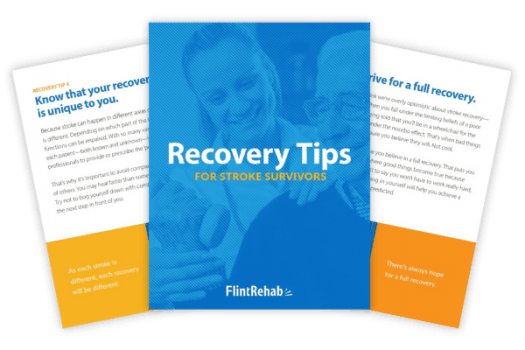When Survivors Can’t Swallow After Stroke: How to Recover from Dysphagia
If you can’t swallow after stroke, it’s likely that you have a condition known as dysphagia. This causes difficulty controlling the oral muscles responsible for swallowing. Dysphagia should be taken very seriously because it can lead to complications such as aspiration pneumonia, which occurs when food or drink is accidentally inhaled and causes infection in the lungs.
This article will explain everything you need to know about difficulty swallowing after stroke as well as the recovery process. Use the links below to jump straight to any section:
What Causes Dysphagia After Stroke?
Dysphagia is a condition characterized by impaired control over the muscles in the throat responsible for swallowing. There are different types of dysphagia, but most stroke survivors develop oropharyngeal dysphagia, which is caused by the neurological impact of the stroke.
When a stroke damages the part of the brain that controls your throat muscles, such as a stroke in the motor cortex or brain stem, the brain cannot send the correct signals to those muscles anymore. As a result, this can inhibit the survivor’s ability to control the muscles necessary for swallowing, leading to dysphagia.
The severity of dysphagia ranges from minor difficulty to the inability to swallow after stroke at all. Survivors with dysphagia may require alternative means of feeding, such as soft foods or, in severe cases, a feeding tube.
Fortunately, dysphagia often improves within the first two weeks after a stroke for most survivors. For individuals that do not experience a quick recovery, rehabilitation can help maximize chances of long-term improvement and a return to normal swallowing function.
Rehabilitation is important because serious complications can occur if dysphagia does not improve. Before we dig into the methods for rehabilitation, let’s discuss these complications.
Potential Complications When Survivors Can’t Swallow After Stroke
Dysphagia is a condition that should be taken very seriously. It not only affects the survivor’s ability to eat, but it can potentially affect the lungs too. This is because eating and breathing both begin with the mouth; and if you can’t swallow after stroke, you can be at a greater risk for lung complications.
For example, survivors with dysphagia are at a greater risk of aspiration pneumonia, which occurs when food or drink is inhaled on accident. When the muscles of the throat and esophagus are not functioning correctly, foods or liquids may enter the airway instead of being swallowed, which can bring bacteria into the lungs and cause infection.
Dysphagia and difficulty swallowing after stroke also increase the risk of choking. Survivors with dysphagia must work closely with a speech-language pathologist (also called a speech therapist) in the hospital who will monitor them during mealtimes. They will also evaluate survivors before discharge from the hospital to make sure it’s safe to eat meals independently. However, supervision from a caregiver or family member will be strongly recommended for safety.
Finally, another potential complication of dysphagia is malnutrition. When survivors cannot eat or drink like they used to, they may choose not to eat at all. Furthermore, some survivors must use thickening agents to thicken their foods, which can be unappetizing and contribute to meal skipping. In fact, studies estimate that around 20% of stroke survivors are malnourished, which is why it is so important to monitor nutrition closely.
All these complications are the reason why swallowing difficulties after stroke are taken very seriously by your medical team. Fortunately, there are many steps you can take to help rehabilitate your ability to swallow.
How to Improve Swallowing After a Stroke
Swallowing is a motor skill that many stroke survivors can relearn through rehabilitation. Using motor-specific rehabilitation methods, swallowing skills can become easier and more efficient, leading to improved nutrition and quality of life.
Here are some steps you can take to maximize your chances of regaining the ability to swallow after stroke:
Work with a Speech-Language Pathologist
A speech-language pathologist is a specialist highly trained in speech disorders, which includes swallowing problems like dysphagia. While swallowing doesn’t involve talking, it is lumped into the category of speech because it involves your oral muscles. A speech-language pathologist (SLP) will be able to assess your unique condition and create an effective rehabilitation program for you.
Practice Swallowing Exercises
It’s likely that your speech-language pathologist will assign you various swallowing exercises to practice both together and on your own at home. These exercises may not involve the direct act of swallowing but instead will train the oral muscles in the mouth to help improve oral motor control.
The goal of speech and swallowing exercises is to rewire the brain through neuroplasticity, the process the brain uses to create new connections and heal after stroke. Practicing swallowing exercises repetitively stimulates neuroplasticity and encourages new neural networks to form, improving motor function. With enough time and practice, this will maximize your chances of regaining control of the ability to swallow.
Ask your SLP to send you home with some swallowing exercises to practice on your own. The next step will also help with this.
Utilize Apps with Oral Motor Exercises
Due to the critical nature of dysphagia and the need for survivors to work directly with an SLP, there aren’t many apps available for stroke survivors with swallowing problems. Still, it’s imperative to practice your exercises both with your therapist and at home. To help with accountability, you can use apps designed for aphasia (a language disorder) as the exercises in these apps often overlap with exercises for dysphagia.
For example, the Lingraphica SmallTalk Oral Motor Exercises app contains exercises to help improve swallowing after stroke. Talk to your therapist to see if they can prescribe specific exercises from the app for you to practice at home. This can help you stick with an at-home routine versus doing it alone without any guidance or feedback.
Talk to Your Therapist About Electrical Stimulation
Most survivors are familiar with electrical stimulation for stroke rehabilitation — but often in the context of improving leg or arm movement. However, electrical stimulation can help with all kinds of motor recovery, including dysphagia and oral motor skills.
Electrical stimulation works by applying gentle electrical impulses to the muscles around your throat. This helps send extra stimulation to the brain to encourage neuroplasticity. There is growing evidence to show that using electrical stimulation alongside rehab exercises can help boost your results. Work closely with your therapists to determine if electrical stimulation may be an appropriate addition to your rehab plan.
If you are a good candidate for electrical stimulation, your therapist will need to help you order a device and train you how to use it. They can show you where to safely place the electrodes as well as what settings you should use.
Eat Safely by Using Compensation Techniques
Although swallowing exercises and electrical stimulation are some of the most effective ways to regain the ability to swallow after stroke, results still take time. In the meantime, it’s important to protect your safety by minimizing your risk of choking or having silent aspirations (inhaling food or drink into the lungs without developing symptoms).
Here are some tips to improve your safety with dysphagia:
- Eat soft foods – they’re easier to chew and lead to less fatigue, helping you eat a sufficient amount of food to prevent malnutrition
- Drink thick liquids – thick beverages move slower than thin liquids, reducing your risk of choking or aspirating
- Focus on sitting up straight – eating or drinking in a position that isn’t upright is difficult and also dangerous as it increases the chances of choking or aspirating
- Eat slowly – this reduces your risk of choking by making sure food is chewed appropriately
- Avoid foods of varying consistencies like chunky soup – this is complicated and can be unsafe to eat with dysphagia
- Add moisture to foods – adding liquids such as milk, broth, juice, or gravy to foods can improve ease of swallowing
These compensation techniques can help protect your safety while you continue with your recovery from stroke. Please note that your speech-language pathologist will be the one to determine what texture of foods and liquids are safe for you at any given point in your recovery.
They may recommend pureed foods and thickened liquids in the beginning of your recovery and progress you to more textured foods when it’s safe. As you slowly regain your ability to swallow after stroke, make sure someone is around as you begin to eat new foods.
How Long Does Dysphagia Last After a Stroke?
Studies show that around 50% of stroke survivors experience dysphagia and most individuals with dysphagia recover within two weeks. However, every stroke is different and therefore recovery will be different for each individual. Sometimes dysphagia goes away on its own via a phenomenon called spontaneous recovery. Chances of spontaneous recovery are higher if your stroke was mild.
Generally speaking, more severe strokes will lead to more persistent dysphagia, depending on the location and size of the stroke. When dysphagia is severe, feeding tubes may be required initially to avoid malnutrition, although these can be removed once swallowing ability improves.
While your stroke recovery timeline will be highly unique to you, adherence to a consistent rehabilitation plan can maximize recovery and quicken your return to normal activities.
Outlook for Stroke Survivors with Dysphagia
When survivors can’t swallow after stroke, this is a sign of dysphagia. Dysphagia should be taken seriously as this can lead to other complications. Working alongside a speech-language pathologist is a must. These specialists can diagnose any speech- or swallowing-related issues, suggest appropriate compensation techniques, and provide suitable exercises to help retrain the brain to control the oral muscles.
Recovery time varies from survivor to survivor. Some survivors regain the ability to swallow within the first two weeks while others must pursue further rehabilitation to encourage the brain to rewire itself. We hope this article helped explain dysphagia and point you in the right direction to regain the ability to swallow after strok
Keep It Going: Download Our Stroke Recovery Ebook for Free

Get our free stroke recovery ebook by signing up below! It contains 15 tips every stroke survivor and caregiver must know. You’ll also receive our weekly Monday newsletter that contains 5 articles on stroke recovery. We will never sell your email address, and we never spam. That we promise.
